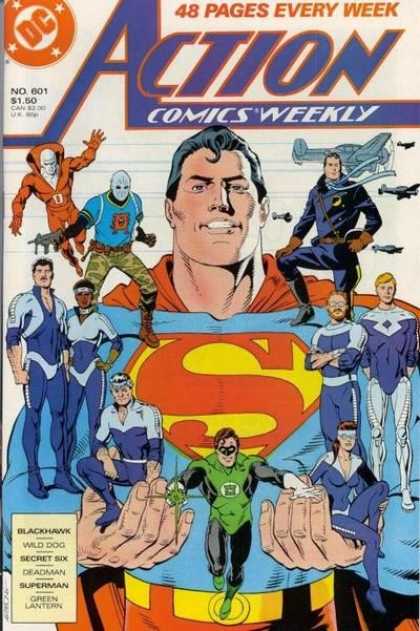 Within a month of each other will come two Superman landmarks: the appearance of Superman on the series finale of Smallville, the longest running comic-based show in history, and just weeks prior the release of the landmark 900th issue of Action Comics (the highest numbering goes to UK-based 2000 AD, which is well over 1,000 weekly issues).
Within a month of each other will come two Superman landmarks: the appearance of Superman on the series finale of Smallville, the longest running comic-based show in history, and just weeks prior the release of the landmark 900th issue of Action Comics (the highest numbering goes to UK-based 2000 AD, which is well over 1,000 weekly issues). Action is the first super hero comic to legitimately reach 900 issues. By legitimately, I refer to Marvel’s releasing of a special 900th issue of Deadpool and Wolverine around the time Superman and Batman were due to reach their 700th issues in 2010 (and following, three 1000th issues for Deadpool, Wolverine and Spectacular Spider-Man since) with none of those titles even coming close to those numbers, even when you add together their various incarnations. But, even Action’s #900 is misleading as it’s really DC’s SECOND oldest title, behind its namesake Detective Comics, whose 876th issue was just released.
What? What is this craziness? How is the older book 14 issues behind the pace? Read on!
Action Comics’ claim to fame is being the book that introduced not only Superman, but the super hero genre as a whole. In 1938, Jerry Siegel and Joe Shuster pitched their creation, originally a malevolent force akin to Lex Luthor with mind-powers, to then-National Allied Publications with the alteration of him being a hero. Action, like many books in the Golden Age, was an anthology that featured other characters in their own strips. As the economy changed and the publisher was forced the reduce the size of the book rather than raise the price, the other strips were gradually phased out until Superman took dominance. It should be noted that when it was decided to launch Superman in his own solo book in 1939, that was another industry first to have a single character for a single book.
In 1986, the book was temporarily halted with #583 to allow John Byrne’s mini-series The Man of Steel, which sought to revamp and redefine Superman’s origin in the midst of conflicting continuity over the years, to run and establish the new status quo. Two years later, DC sought a return to the anthology format for Action and turned it into a weekly book with #601. The weekly format was nixed with #643, but the book was well-past Detective, coupled with Detective’s bi-monthly format back in the ‘70s when Action originally overtook it.
Action Comics #900 presented the conclusion to a Lex Luthor story that had been running in the book since #890, giving Superman a break from the title while focus was placed on J. Michael Straczynski’s “Grounded” arc in Superman’s other book. However, that distinction is misleading in that while the Lex story was brought to a close, the tie-in return of Doomsday story was left on a cliffhanger to continue on. The rest of the book featured several short Superman stories, including the most controversial one of Superman renouncing his American citizenship in order to become a hero without borders.
Over at the Marvel Comics camp, their steady climb to such landmarks slowly continues. Marvel’s progress is hampered by continual re-launches, re-numberings, and book shifting. Marvel has long run under the belief that higher issue numbers are the major factor in declining readership. As a result, in 1996 Marvel ended and re-launched Captain America, Fantastic Four, Iron Man and Avengers with new #1s, as well as experimenting by setting them apart in an all-new universe. The experiment ended with their #13s, and the books were once again re-launched with new #1s, restored to their original universes. Thor’s own second run would being two years later, Iron Man would go on to a third run, and Captain America would see two more launches.
In 1998, Daredevil’s title was ended and re-launched under the new, darker-toned Marvel Knights imprint under scribe Kevin Smith and artist Joe Quesada, which led to a resurgence of the character’s popularity. They attempted that again in 1999 with Spider-Man by reducing the number of titles he had and re-launching two of them. Despite spending the first half of the ‘70s cancelled and in reprints, Uncanny X-Men is Marvel’s longest single-run title, having never received a new number during its run (it was temporarily replaced by Astonishing X-Men for four months for the Age of Apocalypse event, as was every X-Men book).
When Joe Quesada became Editor-in-chief of Marvel, he began an initiative to restore the original numbering of the various re-launched titles. For a period, the books featured a dual number on their covers: the current number of that run, and a lighter-toned original number that the book would have reached without restarting. As titles began gradually reaching their 500th, and later 600th, issue, Marvel began to revert the numbers back to their original levels. DC did this as well with their Wonder Woman and Superman titles, Wonder Woman having received a second volume in 1986 and Superman’s original book becoming Adventures of Superman, allowing for a new Superman #1 following the conclusion of The Man of Steel. Both titles were returned to their original numbering, Superman upon reaching #650 and Wonder Woman with #600.
With Detective Comics reaching #900 in 14 months, the race is on for the next comic milestone.




No comments:
Post a Comment